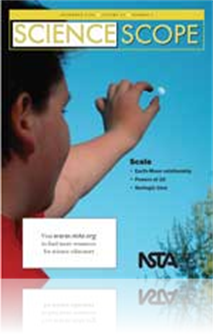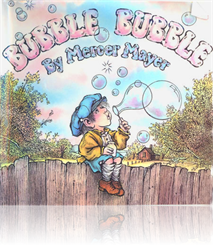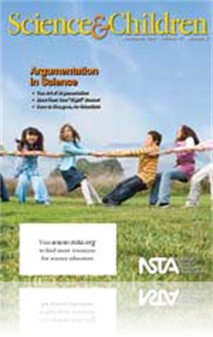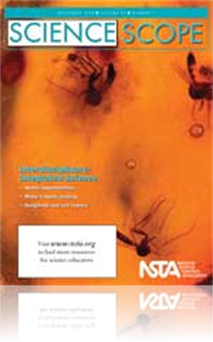All Resources
Journal Article
Science Sampler: Giants don’t exist in the real world—Challenges of teaching scale and structure
Issues that relate to the unifying theme of scale, as defined by the National Science Education Standards (NRC 1996) and Science for All Americans (AAAS 1989), are common in both science and everyday life. Until recently, there has been little resear...
Journal Article
Methods and Strategies: The Reflective Assessment Technique
Teachers often rely on student questions, their observations of students at work, and their own intuition to monitor how well students are learning. However, the authors found that teachers learn more about their students when they use the four-step ...
Journal Article
The United States has a significant deficit in the number of university students choosing to major in science, technology, engineering, and mathematics (STEM) and subsequently entering STEM professions (National Science Board 2008). One way to addres...
Journal Article
Editor’s Roundtable: All things great and small
Middle level students often demonstrate limited familiarity with extremes, whether in distance, time, temperature, speed, or size: and they can have poor measuring skills and an inadequate number sense. The can make scale a very difficult concept for...
Journal Article
The declining cost of computers and wireless networks has made laptop programs more affordable than ever. At the same time, the internet resources available to teachers and students have grown exponentially in the 15 years since web browsers first be...
Journal Article
Quarked!TMAdventures in the Subatomic Universe is a free, educational website developed by a team of physicists, educators, and designers at the University of Kansas to introduce students to scale and the nature of matter. In this article the authors...
Journal Article
Natural Resources: Winter Secrets
The obvious signs of winter: red noses, colorful scarves, fidgety students. The not-so-obvious? A gall on a branch, red berries, shortening days. This month, Natural Resources focuses on print resources—appropriate for the season for lurking in a l...
Journal Article
Science Shorts: Snowflake Symmetry
Even if you get snow in your area, studying real snowflakes in situ can be challenging, but you can still develop a dynamic, hands- and minds-on exploration that can be conducted year-round. Images of actual snowflakes not only help students better v...
Journal Article
The Early Years: Paths of Light
Exploring light is part of the National Science Education Content Standard B: Physical Science. Introduce reflection when you see children noticing their reflection in mirror or window by asking them what it means. While playing with a mirror, childr...
Journal Article
I teach biology and anatomy, and the most frequently asked health questions I get deal with sleep deprivation. Could you provide some information on this topic?...
Journal Article
Students should understand both the science and the engineering models of experimentation. Since students are often predisposed to using the engineering model, teachers must intentionally design activities that better reflect the nature of scientific...
Journal Article
Commentary: Working With Elementary and Middle School Science Teachers
Have you ever seen a fellow high school science teacher throw up his or her hands and say, “What are they teaching kids in elementary- and middle-level science?” Perhaps rather than pointing fingers, we should be working together with these teach...
Journal Article
Tried and True: How old? Tested and trouble-free ways to convey geologic time
Geologic time, or the time frame of our planet’s history, is several orders of magnitude greater than general human understanding of “time.” When students hear that our planet has a 4.6-billion-year history, they do not necessarily comprehend t...
Journal Article
“I have no energy! Energy is everywhere! Solar energy comes from the Sun. Energy drinks give you energy!” These are the typical responses from sixth-grade students when asked about what they know about energy. Students are often aware that energy...
Journal Article
Scope on the Skies: Urban Legends
Urban legends become widespread from people simply not asking “Are you sure?” or looking into the topic and learning more before making a decision. But urban legends are also a great way to teach students to become good questioners—skeptics if ...
Journal Article
Everyday Engineering: Holiday blinkers
Many examples of engineering go unnoticed because they are so much a part of our daily lives that we rarely give them much thought. When you decorate your house with holiday lights, you probably do not think about the engineering that was needed to p...
Journal Article
The study of polar exploration is fascinating and offers students insights into the history, culture, and politics that affect the developing sciences at the farthest ends of Earth. Therefore, the authors think there is value in incorporating polar e...
Journal Article
Solar Radiation: Harnessing the Power
My NASA Data (Chambers et al. 2008) is a teaching tool available on NASA’s website that offers microsets of real data in an easily accessible, user-friendly format. In this article, the authors describe a lesson plan based on an activity from My NA...
Journal Article
Crystals are beautiful structures—yet they occur naturally in dirty and remote places. In the inquiry-based activity described here, students will enjoy the process of creating their own crystals and using microscopes to examine them. It demonstrat...
Journal Article
Career of the Month: An Interview With Patent Attorney-in-Training Peter Brown
From money-making inventions we think of in the middle of the night to scientific breakthroughs discovered in labs, patents help us protect our original ideas from copycats. With our ideas—legally dubbed intellectual property (IP)—safeguarded, we...
Journal Article
Science 101: How do the new fluorescent lightbulbs work?
This is a timely question; given that in 2012 incandescent bulbs (the regular lightbulbs you’ve used for many years) won’t meet energy efficiency standards and will be phased out. To address the question, the author will explain how incandescent ...
NSTA Press Book
With magic bubble solution, a boy discovers that he can blow any kind of bubble imaginable: a kangaroo, a bird, a car, or a boat. Mercer Mayer's colorful illustrations enliven this engaging tale of mysterious bubbles....
By Mercer Mayer
Journal Article
In this article, the authors present a sequence of activities from a curriculum about light for third and fourth graders that supports students in learning to disagree like scientists. This sequence of activities helps students discuss reasons for th...
Journal Article
This article presents a model of collaborative inquiry for groups of science teachers who want to systematically improve their practice through analyses of student work. The five-phase APEXST (Advancing High-Leverage Practices by Examining Student Th...
Journal Article
Millennials are the generation born from 1982–2002, and they are in your middle school classroom today. Some people have referred to them as the iGeneration and the Net Generation, due to their being weaned on technology. They have also been called...
Journal Article
Teaching Through Trade Books: Discover Reading
We often gloss over the history of science—the women and men who have made advancements in the area of scientific discovery. These notable individuals are the backbone of our field. This month, we honor these scientists by encouraging children to r...
Journal Article
A New Twist on “Mystery Boxes”
In the activity described in this article, students learn about observation, interpretation, and argumentation. Students are led through several stages of observation and inference about an unknown object, during which they learn the value of represe...
Journal Article
Commentary: Seven Steps to Teaching With Inquiry
Science is more than a collection of facts—it is a way of thinking and exploring our world that leads to understanding about what is happening around us. This month’s Commentary presents seven steps that are designed to help science educators use...









